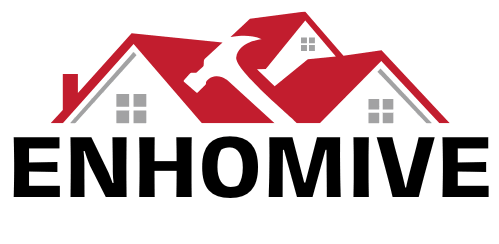15 Home Office Organization Ideas
A well-organized home office is the foundation of productivity, creativity, and professional success in today’s work-from-home world. Whether you’re managing a dedicated office space or carving out a productive corner in a shared room, effective organization systems can transform chaos into clarity and boost your efficiency dramatically.

The key lies in creating systems that not only look aesthetically pleasing but also function seamlessly with your work style and daily routines. From maximizing vertical storage to implementing digital organization strategies, the right organizational approach can reduce stress, save time, and create an environment where you can do your best work.
These 15 comprehensive organization ideas will help you design a home office that supports your professional goals while maintaining the comfort and flexibility that makes working from home so appealing.
Vertical Wall Storage System

Transform empty wall space into a highly functional storage powerhouse using a combination of floating shelves, pegboards, and wall-mounted organizers that keep essential items within easy reach while maintaining a clean, uncluttered desk surface. This vertical approach maximizes storage capacity in even the smallest office spaces while creating visual interest and organizational efficiency.
Install floating shelves at varying heights to accommodate different types of materials, from books and binders to decorative storage boxes and frequently used supplies. Pegboards offer incredible flexibility, allowing you to rearrange hooks, baskets, and specialized organizers as your needs change over time.
The beauty of vertical storage lies in its ability to keep everything visible and accessible while freeing up valuable desktop real estate for actual work activities. Consider incorporating both open storage for items you use frequently and closed storage for supplies that might create visual clutter.
Pro Tips:
- Install shelves at heights that correspond to your seated and standing eye levels
- Use consistent storage containers and colors for a cohesive, professional appearance
- Include a mix of open and closed storage to balance accessibility with visual calm
Desktop Command Center
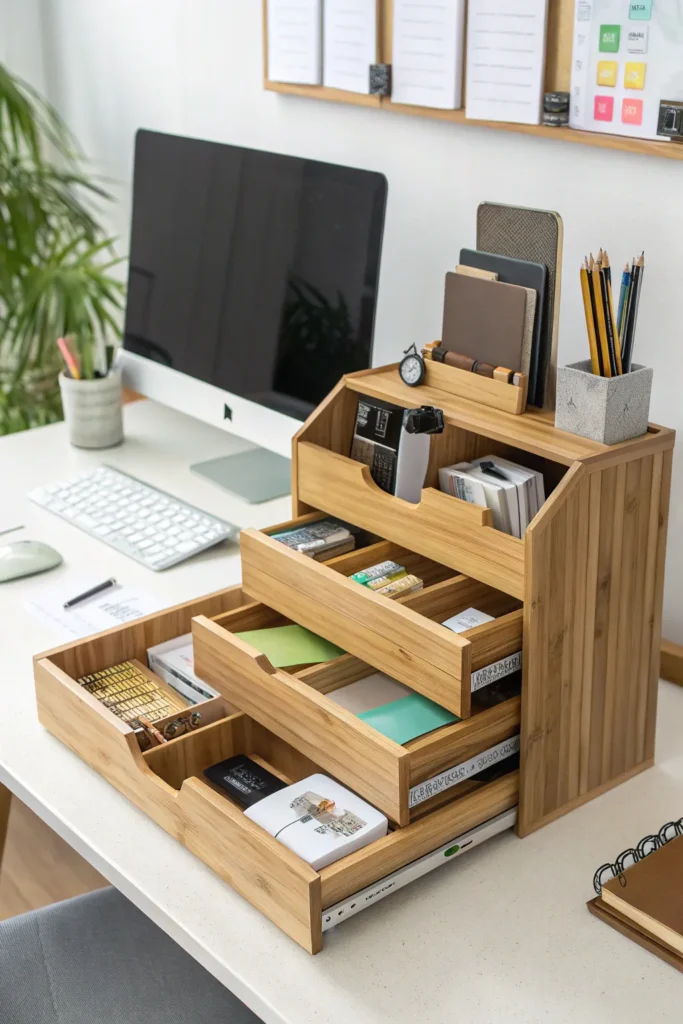
Create a centralized desktop command center using tiered organizers, desktop file sorters, and multi-compartment trays that keep daily essentials organized and instantly accessible. This system acts as mission control for your workday, ensuring that pens, papers, charging cables, and other frequently used items have designated homes that prevent desktop chaos.
Choose organizers with multiple levels and compartments to maximize the efficiency of your desktop footprint. Bamboo, acrylic, or metal organizers can complement your office aesthetic while providing the durability needed for daily use. Include specific spots for items like business cards, sticky notes, paper clips, and charging stations.
The command center should be positioned within easy reach of your primary work area but shouldn’t obstruct your computer screen or create visual distraction. Regular maintenance and the discipline to return items to their designated spots will keep this system functioning effectively.
Pro Tips:
- Select organizers with removable compartments for easy cleaning and reconfiguration
- Include a small tray specifically for items that tend to migrate like paper clips and rubber bands
- Position the command center on your dominant hand side for natural accessibility
Filing Cabinet Organization System
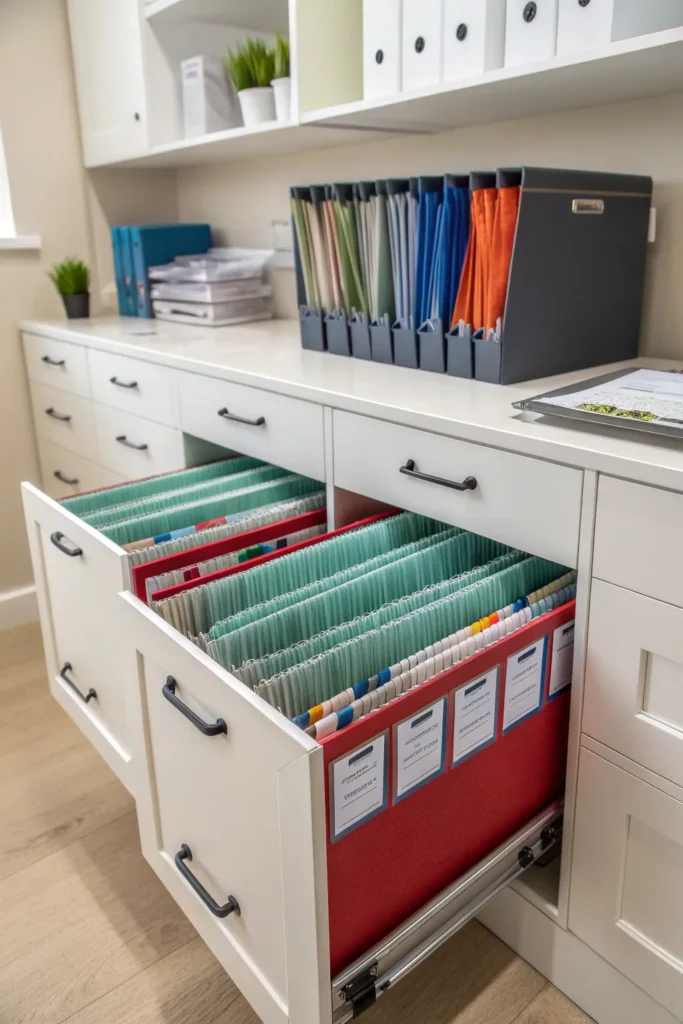
Implement a comprehensive filing system using a combination of hanging folders, color-coded tabs, and clearly labeled categories that make document storage and retrieval effortless. A well-organized filing system serves as the backbone of office organization, providing secure storage for important documents while keeping them easily accessible when needed.
Develop a consistent labeling system that makes sense for your specific work requirements, whether that’s alphabetical, chronological, or project-based organization. Use color-coding to create visual categories that allow for quick identification of different types of documents or priority levels.
Regular maintenance of your filing system prevents the accumulation of outdated documents and ensures that the system continues to serve your needs effectively. Schedule monthly filing sessions to process accumulated papers and purge documents that are no longer needed.
Pro Tips:
- Create a “pending” file for documents that require action before permanent filing
- Use hanging folder tabs consistently positioned in the same location for visual uniformity
- Maintain a master list of file categories to ensure consistent organization over time
Drawer Divider System
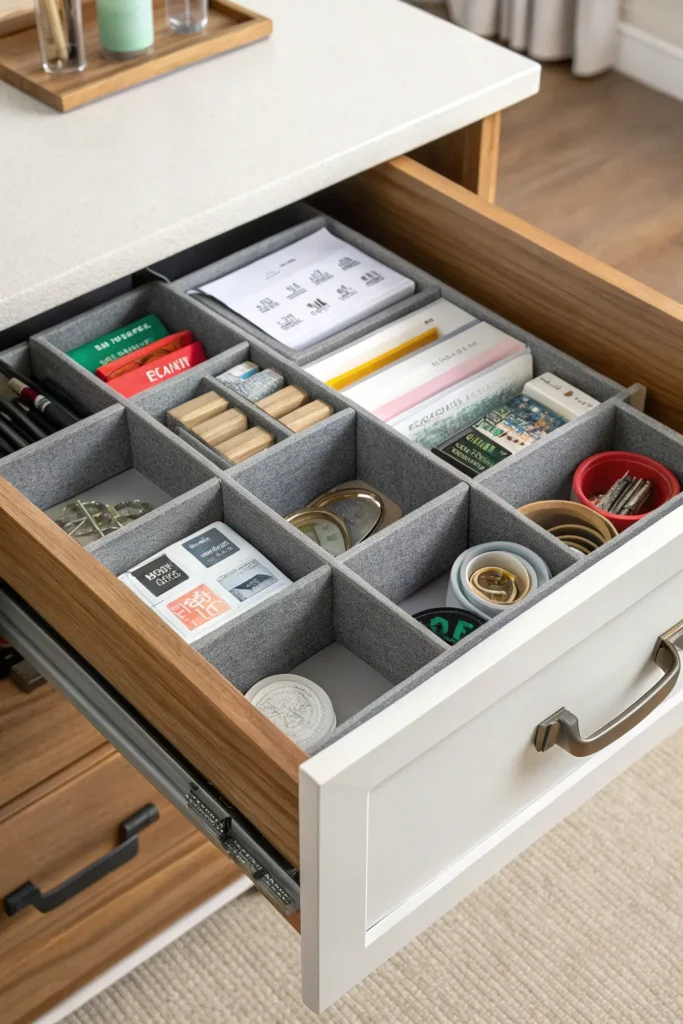
Maximize drawer efficiency using adjustable dividers, small containers, and specialized organizers that transform chaotic junk drawers into perfectly organized storage solutions. Proper drawer organization prevents the frustration of digging through cluttered spaces while ensuring that small office supplies remain accessible and in good condition.
Invest in high-quality adjustable dividers that can be reconfigured as your storage needs change. Use small containers or boxes to corral tiny items like push pins, paper clips, and USB drives that might otherwise get lost in larger compartments.
Consider the frequency of use when organizing drawer contents, placing the most commonly needed items in the most accessible locations. Label containers when necessary to maintain organization even when other family members or colleagues might access your office supplies.
Pro Tips:
- Measure drawer dimensions before purchasing dividers to ensure proper fit
- Use clear containers when possible to quickly identify contents without opening
- Designate one drawer specifically for items you use daily versus weekly supplies
Digital File Organization

Establish a comprehensive digital filing system using cloud storage, consistent naming conventions, and organized folder structures that mirror your physical organization systems. Digital organization is just as important as physical organization in modern home offices, where electronic documents often outnumber paper files significantly.
Create a folder hierarchy that makes logical sense for your work flow, using consistent naming conventions that include dates, project names, or client information as appropriate. Implement a regular backup system to protect important digital files while ensuring accessibility across multiple devices.
Develop habits for immediate digital filing rather than allowing documents to accumulate on your desktop or in download folders. Regular digital decluttering sessions help maintain system efficiency and prevent storage issues from developing over time.
Pro Tips:
- Use date formats consistently (YYYY-MM-DD) for chronological organization
- Create template folder structures for recurring projects or client work
- Set up automatic backup systems to prevent data loss and ensure accessibility
Cable Management Solutions

Eliminate cable chaos using cord organizers, cable trays, and management systems that keep power cords, charging cables, and data connections neat, accessible, and safely routed throughout your workspace. Proper cable management not only improves the visual appeal of your office but also prevents tripping hazards and makes cleaning much easier.
Install under-desk cable trays or clips that route cables along desk edges and legs, keeping them off the floor while maintaining easy access for plugging and unplugging devices. Use cable sleeves or spiral wraps to bundle multiple cables together when they follow the same path.
Label cables at both ends to make troubleshooting and reorganization easier, especially in setups with multiple monitors, printers, or other peripheral devices. Consider wireless alternatives where possible to reduce cable requirements altogether.
Pro Tips:
- Leave extra length in cable runs to accommodate future equipment changes
- Use velcro ties instead of zip ties for cable bundles that might need adjustment
- Install power strips with built-in USB ports to reduce adapter clutter
Mobile Storage Cart
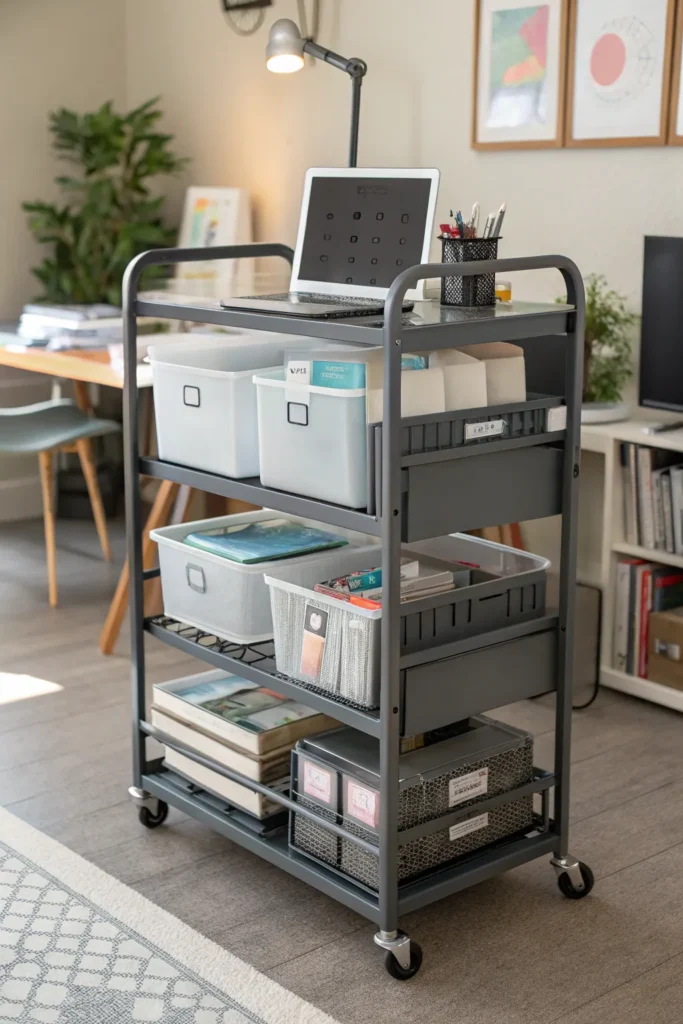
Incorporate a wheeled storage cart that can move between different work areas while providing organized storage for supplies, files, and equipment that need to be accessed from multiple locations. Mobile storage solutions offer incredible flexibility in home offices where space might serve multiple functions throughout the day.
Choose carts with multiple shelves or compartments that can accommodate different types of materials, from office supplies on top shelves to larger items or files in lower compartments. Look for carts with locks if you need to secure sensitive materials or expensive equipment.
The mobility aspect allows you to bring supplies directly to where you’re working rather than constantly walking back to a stationary storage location. This is particularly valuable in home offices that might serve as craft rooms, study spaces, or guest rooms at different times.
Pro Tips:
- Select carts with smooth-rolling wheels that won’t damage floors or create noise
- Choose heights that allow the cart to slide under desks or tables when not in use
- Include a mix of open and closed storage to accommodate different types of supplies
Bulletin Board Command Station
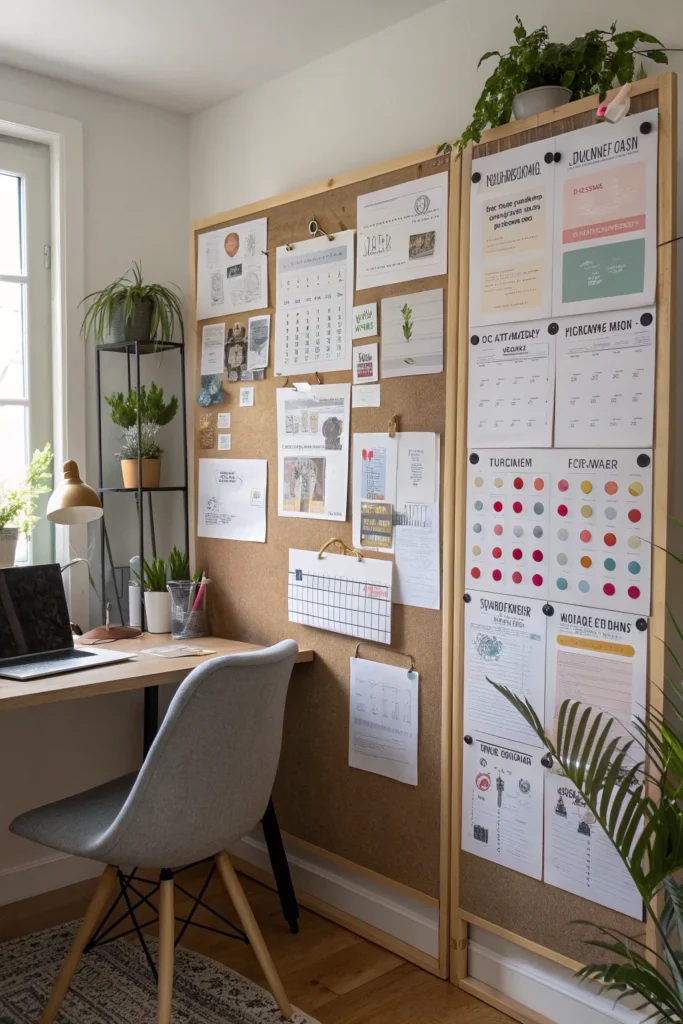
Create an organized information hub using cork boards, magnetic boards, or combination boards that keep important reminders, schedules, and inspiration materials visible and organized. A well-designed bulletin board system serves as external memory, helping you stay on top of deadlines, appointments, and project priorities.
Divide board space into specific zones for different types of information such as current projects, upcoming deadlines, inspirational quotes, or reference materials. Use consistent pushpins, magnets, or clips to maintain a professional appearance while ensuring items stay securely attached.
Position the bulletin board within your natural line of sight from your primary work position so that important information remains visible without requiring special effort to view. Regular maintenance ensures that outdated information doesn’t clutter the space or create confusion.
Pro Tips:
- Use different colored pushpins or magnets to indicate priority levels or categories
- Create a system for rotating outdated information to keep boards current and relevant
- Include a small container attached to the board for spare pushpins or markers
Under-Desk Storage Solutions

Maximize often-overlooked under-desk space using rolling file cabinets, storage ottomans, and hanging organizers that keep supplies accessible while maintaining legroom and visual openness. Under-desk storage can significantly expand your office’s capacity without adding visual clutter or reducing the functionality of your primary work surface.
Consider modular storage solutions that can be reconfigured as your needs change, such as stackable drawers or rolling carts that fit perfectly in your desk’s knee space. Hanging organizers that attach to desk frames can hold supplies like notebooks, charging cables, or reference materials without taking up floor space.
Ensure that under-desk storage doesn’t interfere with comfortable seating positions or create cramped working conditions. The goal is to enhance your office’s functionality while maintaining the ergonomic comfort necessary for productive work sessions.
Pro Tips:
- Measure available space carefully including height clearances for comfortable leg movement
- Choose storage solutions that complement your desk style and color scheme
- Include lighting under desk areas if storage creates shadows that make items hard to locate
Bookshelf Organization System
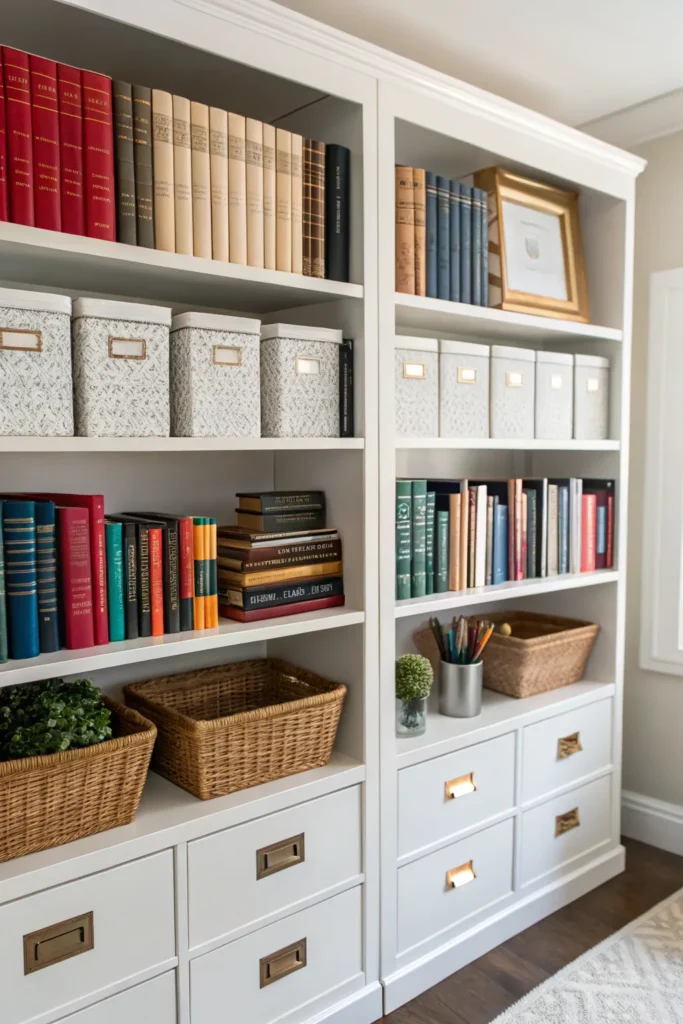
Transform bookshelves into highly functional storage using a combination of traditional books, decorative storage boxes, and organizational accessories that create both practical storage and visual appeal. Well-organized bookshelves can serve multiple functions in home offices, providing storage, display space, and room definition.
Group books by category, size, or color to create visual order while ensuring that frequently referenced materials remain easily accessible. Incorporate attractive storage boxes or baskets to hide less attractive supplies while maintaining the organized appearance of your shelves.
Include personal items, plants, or artwork to prevent shelves from looking purely utilitarian while maintaining the professional atmosphere appropriate for a working space. The key is balancing functional storage with aesthetic appeal that makes your office a pleasant place to spend time.
Pro Tips:
- Use bookends to maintain neat arrangements and prevent books from falling over
- Vary the orientation of books occasionally to create visual interest and accommodate different sizes
- Label storage boxes consistently to maintain organization even when contents aren’t visible
Desktop Charging Station

Establish a dedicated charging station using multi-device chargers, cable organizers, and designated spaces that keep all your electronic devices powered and organized in one convenient location. A centralized charging system prevents the frustration of searching for chargers while reducing cable clutter throughout your office.
Choose charging stations that accommodate multiple device types including smartphones, tablets, laptops, and other electronic accessories you use regularly. Consider stations with built-in cable management to keep charging cables neat and prevent tangling when devices aren’t connected.
Position the charging station in a location that’s convenient for daily use but doesn’t interfere with your primary work activities. Including a small tray or compartment for devices while they’re charging helps maintain organization and prevents scratches or damage.
Pro Tips:
- Select charging stations with surge protection to safeguard expensive electronic devices
- Include wireless charging pads for compatible devices to reduce cable requirements
- Position charging stations away from primary work areas to minimize distraction from device notifications
Project Organization System
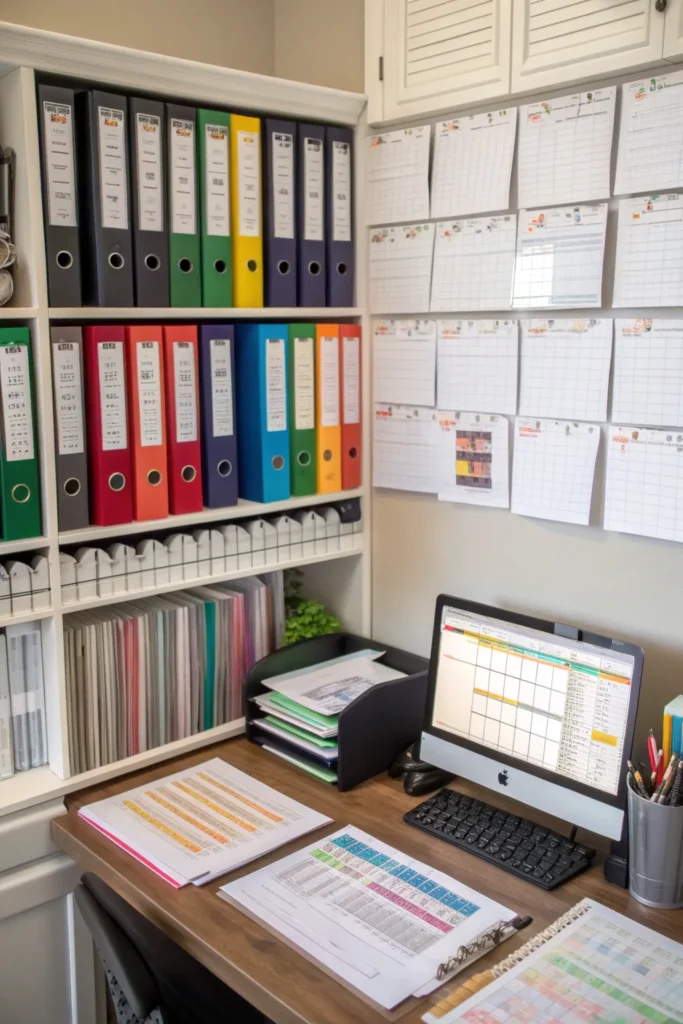
Develop a comprehensive project management system using project binders, color-coded folders, and tracking systems that keep multiple work projects organized and progress visible. Effective project organization prevents important details from falling through the cracks while enabling efficient switching between different work priorities.
Create standardized project folders or binders that include all relevant documents, notes, correspondence, and reference materials for each active project. Use consistent color coding or labeling systems that make project identification quick and intuitive.
Include project tracking sheets or dashboards that provide quick overviews of deadlines, progress, and next steps for each active project. This system overview helps with priority management and ensures that no project gets neglected due to lack of visibility.
Pro Tips:
- Create template project folders that can be quickly customized for new projects
- Use clear sheet protectors for frequently referenced documents that might get damaged
- Maintain both active and completed project storage to preserve records while reducing clutter
Supply Inventory System

Implement a comprehensive supply tracking system using labeled containers, inventory sheets, and reorder reminders that ensure you always have necessary supplies without overbuying or running out of essentials. Good inventory management saves both time and money while preventing work disruptions due to missing supplies.
Use clear, labeled containers to store supplies in categories that match your usage patterns, such as writing instruments, paper products, technology accessories, and administrative supplies. Create visual inventory systems that make it easy to see when supplies are running low.
Develop reorder lists and schedules that ensure supplies are replenished before running out completely. Consider bulk purchasing for frequently used items while being mindful of storage space limitations and expiration dates for certain supplies.
Pro Tips:
- Create a master supply list with preferred brands and suppliers for easy reordering
- Use transparent containers whenever possible to quickly assess inventory levels
- Set up automatic delivery for frequently used supplies to prevent stockouts
Time Management Display
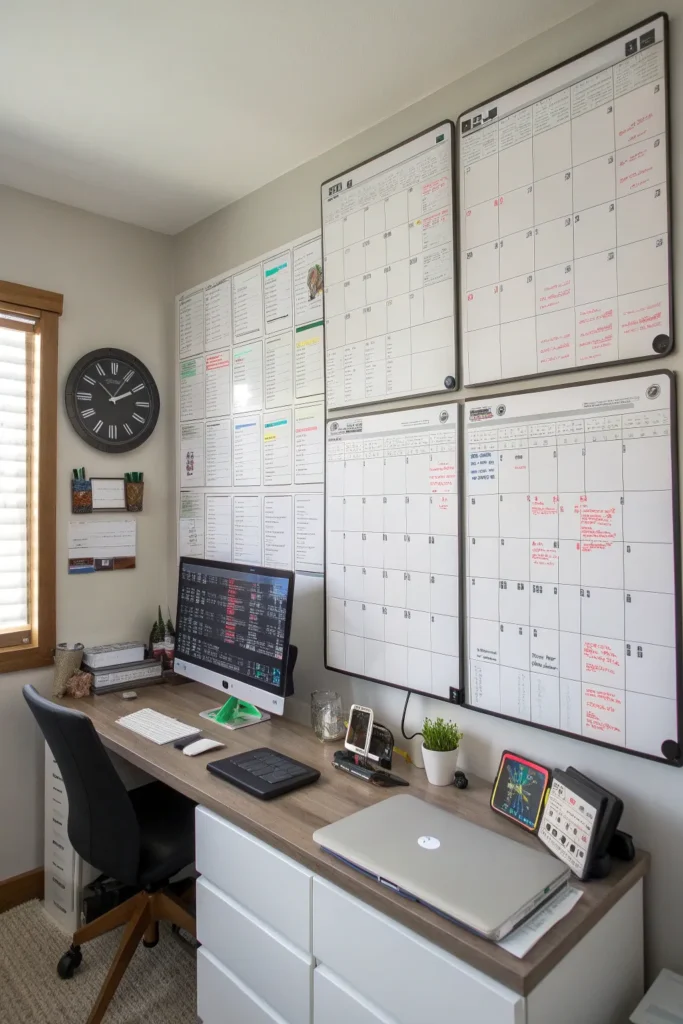
Create visual time management systems using calendars, clocks, and scheduling displays that keep important deadlines and appointments visible while helping maintain focus on daily priorities. Visible time management tools serve as constant reminders and help maintain productive momentum throughout the workday.
Install large wall calendars or whiteboard calendars that provide monthly overviews of important dates, deadlines, and appointments. Include both work-related and personal commitments to maintain life balance and prevent scheduling conflicts.
Consider adding multiple time zone clocks if you work with clients or colleagues in different geographical areas, and include countdown timers or project deadline displays that create urgency for important milestones. The key is making time-related information visible without creating overwhelming visual noise.
Pro Tips:
- Use different colors for different types of commitments to quickly identify priority levels
- Position time displays within natural sight lines from your primary work position
- Update displays regularly to maintain accuracy and relevance for current priorities
Personal Comfort Zone
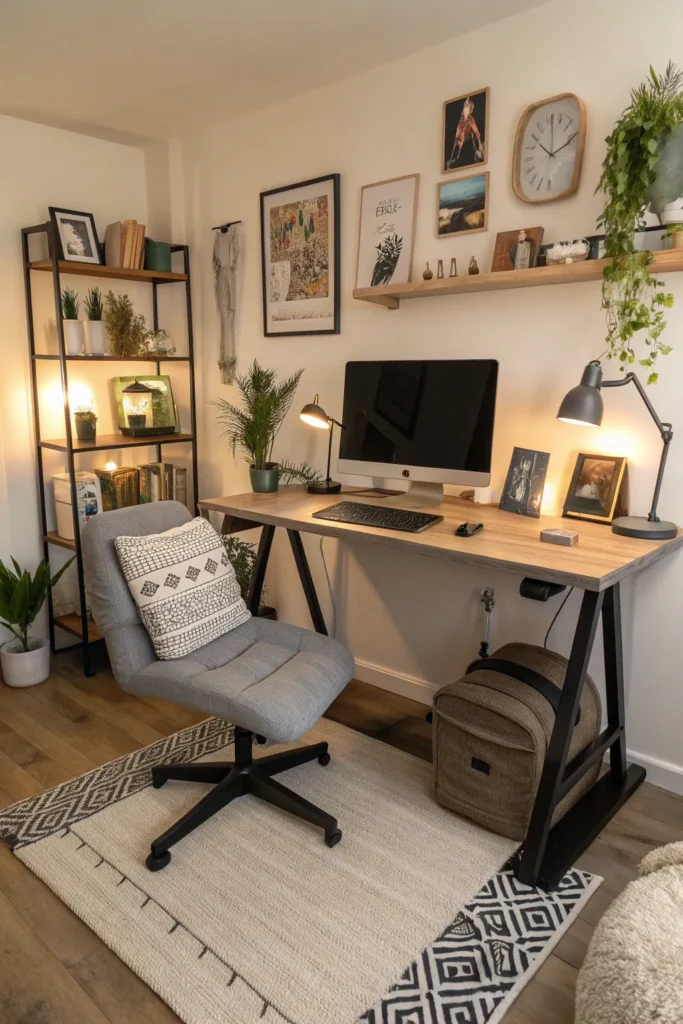
Design a comfortable personal area within your office using ergonomic accessories, personal items, and comfort features that make your workspace inviting and conducive to productive work. A comfortable, personalized workspace reduces stress and increases satisfaction with your work environment.
Include ergonomic supports such as lumbar cushions, footrests, or monitor stands that promote healthy posture and reduce physical strain during long work sessions. Add personal touches like family photos, plants, or artwork that create emotional comfort without becoming distracting.
Consider lighting options that reduce eye strain and create pleasant ambiance throughout different parts of the day. Include temperature control options like fans, space heaters, or throws that help maintain physical comfort regardless of seasonal changes or building heating and cooling limitations.
Pro Tips:
- Choose personal decorative items that inspire motivation rather than distract from work focus
- Include plants that improve air quality while adding natural beauty to your space
- Position comfort items where they provide benefit without interfering with work efficiency
Creating an organized home office is an ongoing process that evolves with your changing work needs and personal preferences. The most effective organizational systems are those that align naturally with your work style and daily routines, making maintenance effortless rather than burdensome.
Remember that organization is not about perfection but about creating systems that support your productivity and reduce stress in your daily work life. Start by implementing one or two of these ideas that address your most pressing organizational challenges, then gradually expand your systems as you experience their benefits.
The goal is to create a workspace that not only looks professional and organized but also functions seamlessly to support your best work while maintaining the comfort and flexibility that make working from home so valuable. Regular evaluation and adjustment of your organizational systems ensure they continue to serve your evolving needs effectively.
